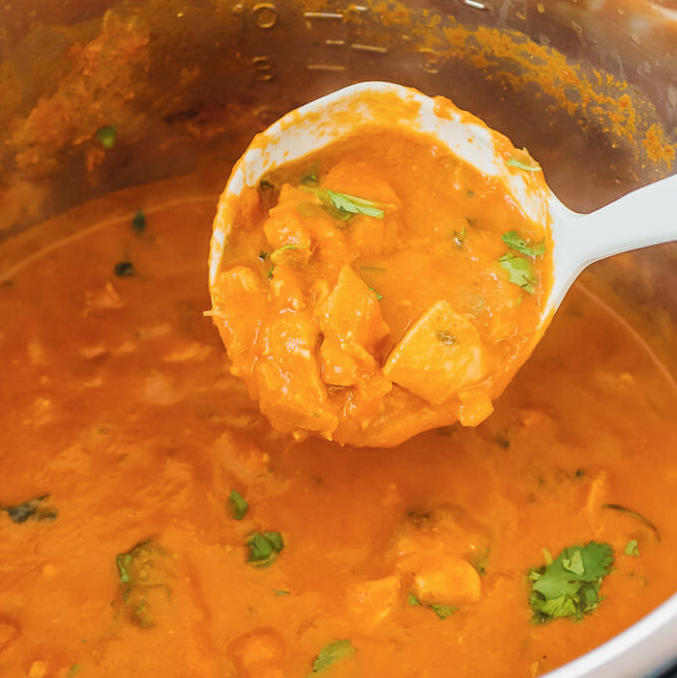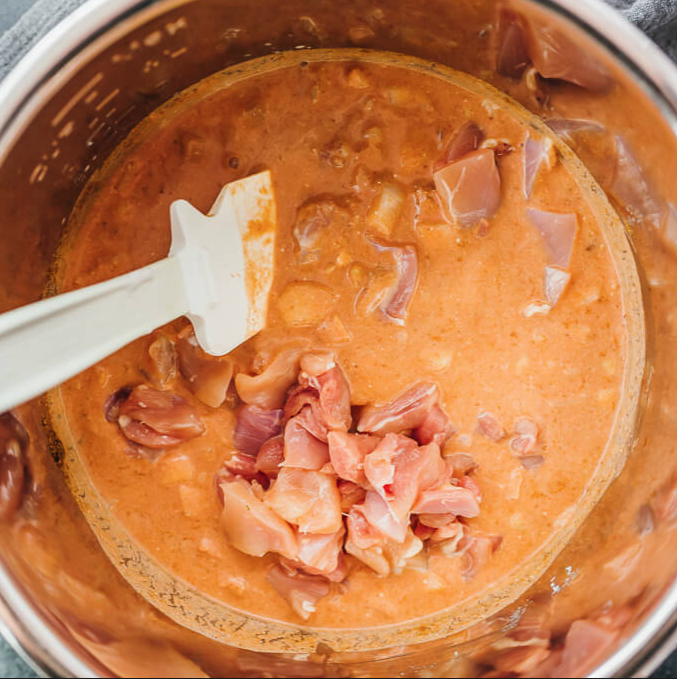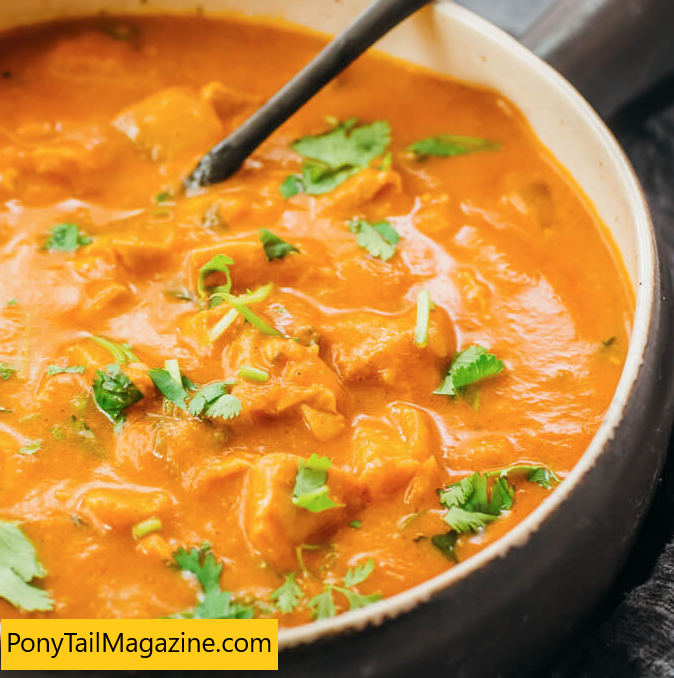This simple recipe is a low carb, pressure cooker version of the popular Indian curry murgh makhani. Tender chicken bites are cooked in a smooth sauce infused with coconut milk, tomato, and aromatic spices — no cream is used. Compared to other cooking methods that require marinating and browning, this recipe is faster and easier with equally delicious results.
Get This Delicious Recipes & Chart
| Prep Time | 20minutes minutes |
| Cook Time | 25minutes minutes |
| Pressurize | 15minutes minutes |
| Servings | 4 servings |

Ingredients
- 1.5 pounds boneless skinless chicken thighs
- 1 small yellow onion, finely chopped
- 5 cloves garlic, minced
- 1 (15-ounce) can tomato sauce
- 1 (13.5-ounce) can coconut milk
- 1/3 cup plain greek yogurt
- 3 tablespoons chopped fresh cilantro
- 2 tablespoons salted butter
Seasonings:
- 1 tablespoon garam masala
- 1 teaspoon ground coriander seed
- 1/2 teaspoon ground cumin
- 1/2 teaspoon table salt
- 1/4 teaspoon ground ginger
- 1/8 teaspoon ground cayenne
Get This Delicious Recipes & Chart
Instructions
1-Add Ingredients: Stir together onions, garlic, tomato sauce, coconut milk, yogurt, and all seasonings in pressure cooker pot. Pat chicken thighs dry with paper towels. Trimming off and discarding excess fat, cut meat into 1-inch chunks. Add meat to pot, stirring until coated with sauce.
2-Pressure Cook: Cover and seal lid. Cook at high pressure for 10 minutes, followed by quick pressure release.

3-Thicken Sauce: Uncover and turn on saute mode for medium heat. Boil until liquid thickens into stew-like consistency, about 15 minutes, stirring occasionally to prevent sticking along bottom of pot. Turn off saute mode.
4-Finish & Serve: Stir in butter and 2 tablespoons chopped cilantro until butter is melted. Serve into bowls, and garnish with remaining 1 tablespoon cilantro.
NOTES & TIPS
(1) Chicken. I use fresh; if yours is frozen, thaw overnight in the fridge. If you don’t mind the chicken being less tender and slightly tougher, you can use chicken breasts instead.
(2) Tomato Sauce. To ensure that the resulting sauce is thick and smooth, use tomato sauce or puree, not chunkier versions like diced or crushed tomatoes. I use canned tomato sauce that is unsalted and plain (no added herbs).
(3) Coconut Milk. Use an unsweetened full-fat version, not light or reduced fat. I’ve used Goya and Chaokoh brands. Before using, stir or shake well because there will be separation in the can. Properly stirred coconut milk should appear thick and creamy, not watery. This recipe uses coconut milk to build the curry sauce, as opposed to heavy whipping cream which does not always work well in a pressure cooker environment. With coconut milk, you don’t have to worry about potential curdling, which means it can be pressure cooked with the rest of the sauce ingredients. It also provides liquid content to help pressurize the pot. Note that you don’t actually taste any coconut flavor in the finished dish, since the spices and other ingredients are strong enough to cover it.
(4) Greek Yogurt. Greek yogurt is used because of its thick consistency; just a moderate amount of it adds a pop of authentic flavor without overpowering. Don’t use American yogurts, which are much thinner. To avoid curdling, use whole milk yogurt with a high fat content, like 5%, and mix the yogurt with other ingredients in the pot while they’re cold or at room temperature, prior to cooking. The yogurt should also be unsweetened and plain — I use the brand Fage. For a dairy-free or paleo option, look for soy, coconut, or almond based plain yogurts at your grocery store. If you can’t find any, you can skip the yogurt altogether without a substantial loss in flavor. The curry will taste noticeably different, but it should still be quite good.
(5) Butter. For a dairy-free or paleo version, skip the butter. The butter adds silkiness to the sauce — and this dish is called Butter Chicken, after all — but since the recipe only calls for a small amount of butter, you can omit this ingredient and it will still taste very similar.
(6) Garam Masala. This is one of those spices that can’t be easily substituted because it gives a characteristic taste to Indian dishes like chicken tikka masala and butter chicken. It’s a blend of ground Indian spices including pepper, cloves, cinnamon, nutmeg, cardamom, and cumin. You can easily buy garam masala online, or you can find it at many U.S. supermarkets.

(7) Cayenne. This amount yields mild spiciness. Adjust as needed to match your preferences; for medium spiciness, use 1/4 teaspoon.
(8) Adding Ingredients. The ingredients are added directly to an unheated pot — you don’t need to brown the chicken first. Browning is not an efficient process in the Instant Pot, since the narrow pot is only 9 inches in diameter. Adding too many chicken chunks at once would cool the pot too much, even on the highest heat level, so you would have to brown in multiple batches to get a good sear on the chicken.
(9) Pressure Cooker Equipment. I use a 6-quart Instant Pot. Other sizes of electric pressure cookers should also work as long as all ingredients fit within the maximum capacity.
(10) Sealing Pressure Cooker. Before cooking, remember to seal the pressure cooker by turning the pressure knob from “venting” to “sealing,” otherwise the pot will not pressurize.
(11) Pressure Release. After cooking, to perform a quick pressure release, turn the knob back to “venting” and wait for the pressure pin to drop before uncovering.
(12) Serving. Butter Chicken goes great with low carb sides like plain fried cauliflower rice, creamed spinach, or roasted vegetables. Leftovers taste just as good the next day; store covered in the refrigerator and reheat in the microwave.
(13) Adjusting Servings. You can scale the ingredients up or down to accommodate a different number of servings. Note that the pressure cooking time remains the same.
(14) Butter Chicken vs. Chicken Tikka Masala. Butter chicken originated in India, whereas chicken tikka masala is more of a British invention; some restaurants use those terms interchangeably. Both dishes use garam masala, a spice blend containing cumin, cardamom, cinnamon, and cloves, but butter chicken tends to be milder. I recommend butter chicken (also available as a stovetop version) for those who prefer a less spiced, more buttery and subtle curry, and chicken tikka masala for those who prefer boldly flavored sauces. I’ve cooked the latter a number of different ways, including stovetop, pressure cooker, and slow cooker.
Get This Delicious Recipes & Chart
NUTRITION
| Makes 4 Servings | Amount Per Serving |
| Calories | 430 |
| Total Fat 30g | 46% |
| Saturated Fat 17g | 85% |
| Cholesterol 133mg | 44% |
| Sodium 590mg | 24% |
| Net Carb | 9.5g |
| Total Carb 12.5g | 4% |
| Dietary Fiber 3g | 12% |
| Sugars | 7.5g |
| Protein | 27g |
Did you make this? Tell us about it!

